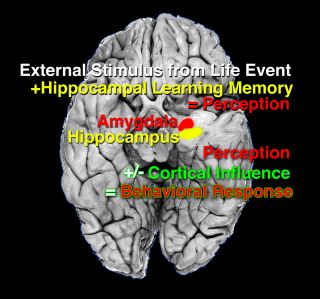
The brain’s job is to protect us.[1, 2] Binge eating is an example of the brain attempting to do this and having it go horribly awry.[3] To protect us from the neurochemical deficits caused by negative emotions, one of the brain’s immediate solutions is to increase dopamine (the brain’s happy dance drug).[3, 4] Regrettably, this occurs in the old mammal brain—home of the fight-or-flight response. Here the mantra is: survive now ask questions later. This part of the brain does not think because in crises action, not thought, increase your survival chances.[5] That’s why you can eat yourself into a fudge coma, while ignoring the thigh karma until you are wearing your skinny jeans as a headband. When you are bingeing, your brain is surviving now by reaping the neurochemical rewards of eating to obviate the immediate threat of negative emotional states.[6]
True the cortex, or thinking part of the brain, can control subcortical structures before you reach the “Does this muumuu make me look fat?” point. However, this requires serotonin. Stress and distractions decrease serotonin.[7] So, if you are stressed, distracted or have serotonin issues—“Houston we have a problem.” This is bad news in our highly stressful world. Functional human brain dynamics are not going to change in our lifetime. Thus, we have to dam this river at the source; i.e. perception because through it we identify, evaluate and gage our responses to external events that generate negative emotion.
Perception in the Brain

The hippocampus is the seat of learning and memory. It compares information from the outside world with its internal belief of how the world should be, in tandem with its belief of your self worth and capabilities. This is all factored into forming a perception of the incoming information. Then, the perception of the incoming information is reported to the amygdala—the brain’s fear center. The amygdala has incoming and outgoing connections to all parts of the brain and body.[8-10] In the case of wild animal attack the amygdala would prepare you for the eventuality of fight or flight. In the case of negative emotions generated by social cues, your brain’s response will be to take the lid off of the neurochemical cookie jar for some dopamine, by consorting with your drug(s) of choice.[11-14]
Evolution forbids the old brain from distinguishing between actual and perceived threat because it is better to run from a noise in case it is a predator, than not run if it is. Thus if a spouse is unfaithful, the neural responses and negative emotion will be the same as if you just believe he or she is. [6]
Many Converging Rivers
Since the developing brain bases its belief of what the world is like, and who you are in that world, on your early experiences, extreme developmental experiences create exaggerated core beliefs. They also cause structural brain changes that affect learning, memory, and in turn perception.[7, 15, 16] These structural changes alter neural systems involved in threat detection causing attentional biases, and peculiar neural activity[7, 17-21] —similar to the way bad spark plugs affect an engine’s fuel efficiency and performance. This neural misfiring is the basis of perception challenges such as misreading social cues, being overly self-referential, hypersensitive etc.[15] These conditions compromise perception, and generate negative emotions that the old brain responds to by generating immediate dopamine from behaviors that are unhealthy in the long run but adhere to its “survive now” motto.[22] Compulsive over use of food, alcohol or drugs are prime examples of this.
Another element is social history. Social history is expressed in genetics and family dynamics. Families hand suffering from generation to generation like passing dinner rolls around at Thanksgiving.[23] This too, contributes to aberrant neural firing affecting attention, learning, memory, and ultimately the perception of threat.[7, 17, 22]
Confirmation bias is a copious brain enterprise and also contributes to distorted perception. The brain is busy and resistant to change. Thus, it looks for things that confirm its original assessments.[24] If you have learned that you are worthless, or life is hopeless, your brain will instinctively look for evidence of that, and ignore evidence to the contrary, creating a downward synergy.
For the sake of efficiency, the brain consolidates and simplifies. Flight-or-flight, for example, is just a consolidation and simplification of millions of human lessons in conflict resolution.[6] This works well for evolution over generations, but not as well for individuals during a lifetime. For example, we all have encountered racially hypersensitive people. One reason for this is, when a person repeatedly experiences racism, his or her brain may consolidate and simplify the message: “racism is the source of my problems.” Then when they encounter a problem their brain's consolidation and simplification causes the perception that it is because of racism even when it is not.

For brevity’s sake, this is an oversimplification of the neural constellates underlying interoceptive awareness (how we feel what we feel) and the neuroanatomy of emotion and perception (why we do what we do). However, the global message is precise: if perception is compromised, the old brain’s influence on behavior, such as hedonic eating, will reflect this. That is the bad news. The good news is: by self-exploration and familiarity with our brain’s nonstandard functionality we can manage the influence our perception has on our behavior.[25-27] If we are hypersensitive, fearful, or suspicious–own it and work with it, but do not expect the world to compensate for it. Simply put, observe yourself within your world, and turn inward to find the resolve to your issues. This requires vigilance, brutal honesty, self-acceptance and the strength to embrace yourself and your circumstances by never wanting what you do not have, or cannot do, more than what you have and can do. We did not order our lives from Amazon, so there is no shame in how our brains work. The only shame is in refusing to learn how to make them work for us in our lives. Remain fabulous and phenomenal.
Click here to receive notices of new post via email
Visit UCLA’s Center for the Neurobiology of Stress Obesity Program
Visit me at UCLA Center for the Neurobiology of Stress
Like Obesely-Speaking on FaceBook
Visit me on The Huffington Post
References
1. Lakatos, L. and Z. Janka, [Evolution of human brain and intelligence]. Ideggyogy Sz, 2008. 61(7-8): p. 220-9.
2. Lindahl, B.I., Consciousness and biological evolution. J Theor Biol, 1997. 187(4): p. 613-29.
3. Adam, T.C. and E.S. Epel, Stress, eating and the reward system. Physiol Behav, 2007. 91(4): p. 449-58.
4. Born, J.M., et al., Acute stress and food-related reward activation in the brain during food choice during eating in the absence of hunger. Int J Obes (Lond), 2010. 34(1): p. 172-81.
5. Sapolsky, R.M., WHY ZEBRAS DON'T GET ULCERS. 2002, NY, NY: McMillan / Holt Books.
6. McEwen, B., Lasley, E, End of Stress as we know it. 2002, Washington, D.C.: Joseph Henry Press.
7. McEwen, B.S., Physiology and neurobiology of stress and adaptation: central role of the brain. Physiol Rev, 2007. 87(3): p. 873-904.
8. Cromwell, H.C. and R.M. Atchley, Influence of emotional states on inhibitory gating: animals models to clinical neurophysiology. Behav Brain Res, 2015. 276: p. 67-75.
9. Shu, S.Y., et al., Interactions among memory-related centers in the brain. J Neurosci Res, 2003. 71(5): p. 609-16.
10. Wittmann, B.C., et al., Mesolimbic interaction of emotional valence and reward improves memory formation. Neuropsychologia, 2008. 46(4): p. 1000-8.
11. Allan, J.D., New directions for the study of overweight. West J Nurs Res, 1998. 20(1): p. 7-13.
12. Gardner, E.L., Addiction and brain reward and antireward pathways. Adv Psychosom Med, 2011. 30: p. 22-60.
13. Hariri, A.R., et al., A susceptibility gene for affective disorders and the response of the human amygdala. Arch Gen Psychiatry, 2005. 62(2): p. 146-52.
14. Kanai, R., et al., Brain structure links loneliness to social perception. Curr Biol, 2012. 22(20): p. 1975-9.
15. McEwen, B.S., Brain on stress: how the social environment gets under the skin. Proc Natl Acad Sci U S A, 2012. 109 Suppl 2: p. 17180-5.
16. McEwen, B.S., Commentary: the ever-changing brain. Neuropsychopharmacology, 2001. 25(6): p. 797-8.
17. McEwen, B.S., Stress and hippocampal plasticity. Annu Rev Neurosci, 1999. 22: p. 105-22.
18. McEwen, B.S., Hormones and the plasticity of neurons. Clin Neuropharmacol, 1992. 15 Suppl 1 Pt A: p. 582A-583A.
19. McEwen, B.S., Structural plasticity of the adult brain: how animal models help us understand brain changes in depression and systemic disorders related to depression. Dialogues Clin Neurosci, 2004. 6(2): p. 119-33.
20. McEwen, B.S., Early life influences on life-long patterns of behavior and health. Ment Retard Dev Disabil Res Rev, 2003. 9(3): p. 149-54.
21. McEwen, B.S., The neurobiology and neuroendocrinology of stress. Implications for post-traumatic stress disorder from a basic science perspective. Psychiatr Clin North Am, 2002. 25(2): p. 469-94, ix.
22. McEwen, B. and E.N. Lasley, Allostatic load: when protection gives way to damage. Adv Mind Body Med, 2003. 19(1): p. 28-33.
23. Candib, L.M., Working with suffering. Patient Educ Couns, 2002. 48(1): p. 43-50.
24. Fugelsang, J.A., et al., Theory and data interactions of the scientific mind: evidence from the molecular and the cognitive laboratory. Can J Exp Psychol, 2004. 58(2): p. 86-95.
25. Barrington, W.E., et al., Perceived stress, behavior, and body mass index among adults participating in a worksite obesity prevention program, Seattle, 2005-2007. Prev Chronic Dis, 2012. 9: p. E152.
26. Bond, A.R., et al., Embodied health: the effects of a mind-body course for medical students. Med Educ Online, 2013. 18: p. 1-8.
27. Carmody, J. and R.A. Baer, Relationships between mindfulness practice and levels of mindfulness, medical and psychological symptoms and well-being in a mindfulness-based stress reduction program. J Behav Med, 2008. 31(1): p. 23-33.




